2006 FORD F SERIES MOTORHOME AND COMMERCIAL CHASSIS change wheel
[x] Cancel search: change wheelPage 25 of 128
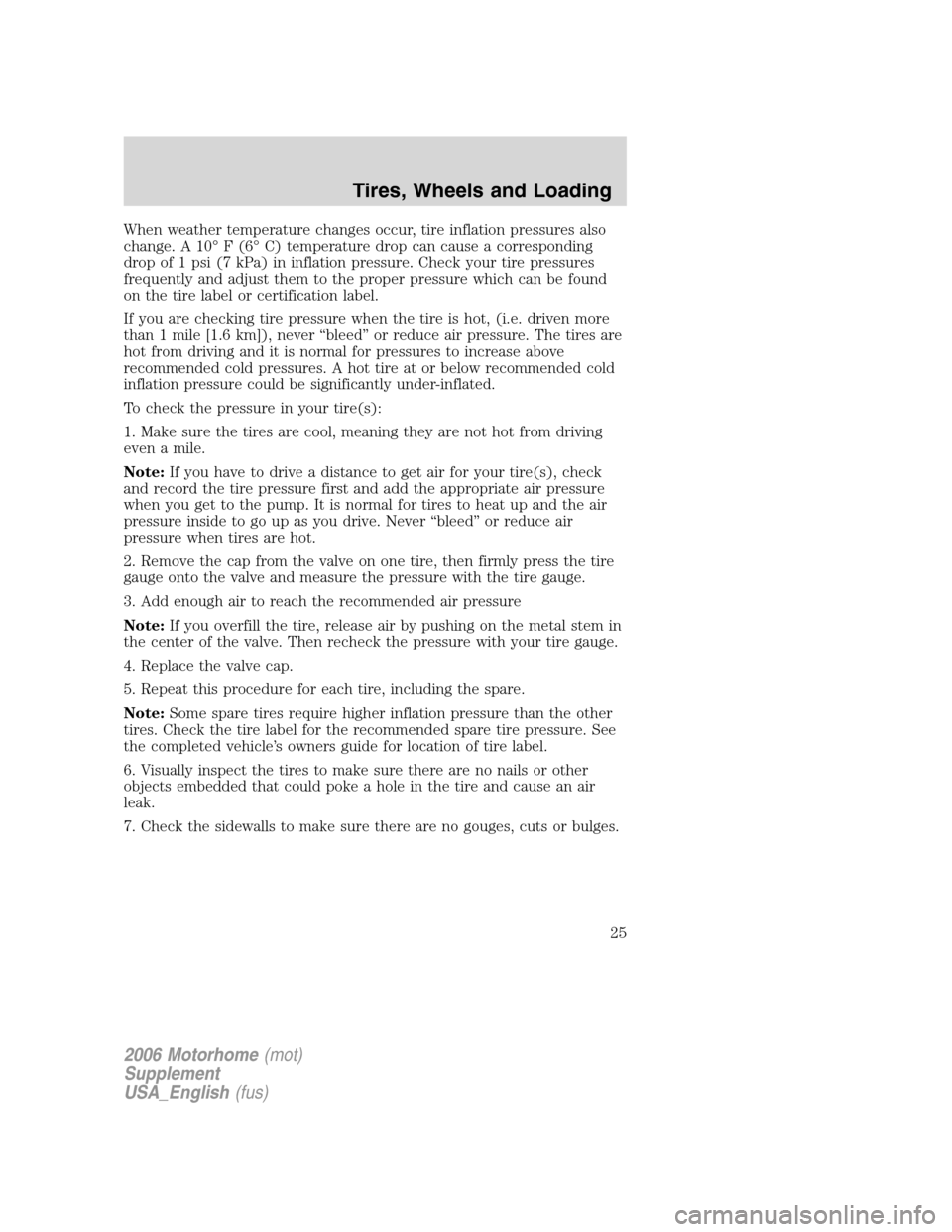
When weather temperature changes occur, tire inflation pressures also
change. A 10° F (6° C) temperature drop can cause a corresponding
drop of 1 psi (7 kPa) in inflation pressure. Check your tire pressures
frequently and adjust them to the proper pressure which can be found
on the tire label or certification label.
If you are checking tire pressure when the tire is hot, (i.e. driven more
than 1 mile [1.6 km]), never “bleed” or reduce air pressure. The tires are
hot from driving and it is normal for pressures to increase above
recommended cold pressures. A hot tire at or below recommended cold
inflation pressure could be significantly under-inflated.
To check the pressure in your tire(s):
1. Make sure the tires are cool, meaning they are not hot from driving
even a mile.
Note:If you have to drive a distance to get air for your tire(s), check
and record the tire pressure first and add the appropriate air pressure
when you get to the pump. It is normal for tires to heat up and the air
pressure inside to go up as you drive. Never “bleed” or reduce air
pressure when tires are hot.
2. Remove the cap from the valve on one tire, then firmly press the tire
gauge onto the valve and measure the pressure with the tire gauge.
3. Add enough air to reach the recommended air pressure
Note:If you overfill the tire, release air by pushing on the metal stem in
the center of the valve. Then recheck the pressure with your tire gauge.
4. Replace the valve cap.
5. Repeat this procedure for each tire, including the spare.
Note:Some spare tires require higher inflation pressure than the other
tires. Check the tire label for the recommended spare tire pressure. See
the completed vehicle’s owners guide for location of tire label.
6. Visually inspect the tires to make sure there are no nails or other
objects embedded that could poke a hole in the tire and cause an air
leak.
7. Check the sidewalls to make sure there are no gouges, cuts or bulges.
2006 Motorhome(mot)
Supplement
USA_English(fus)
Tires, Wheels and Loading
25
Page 27 of 128
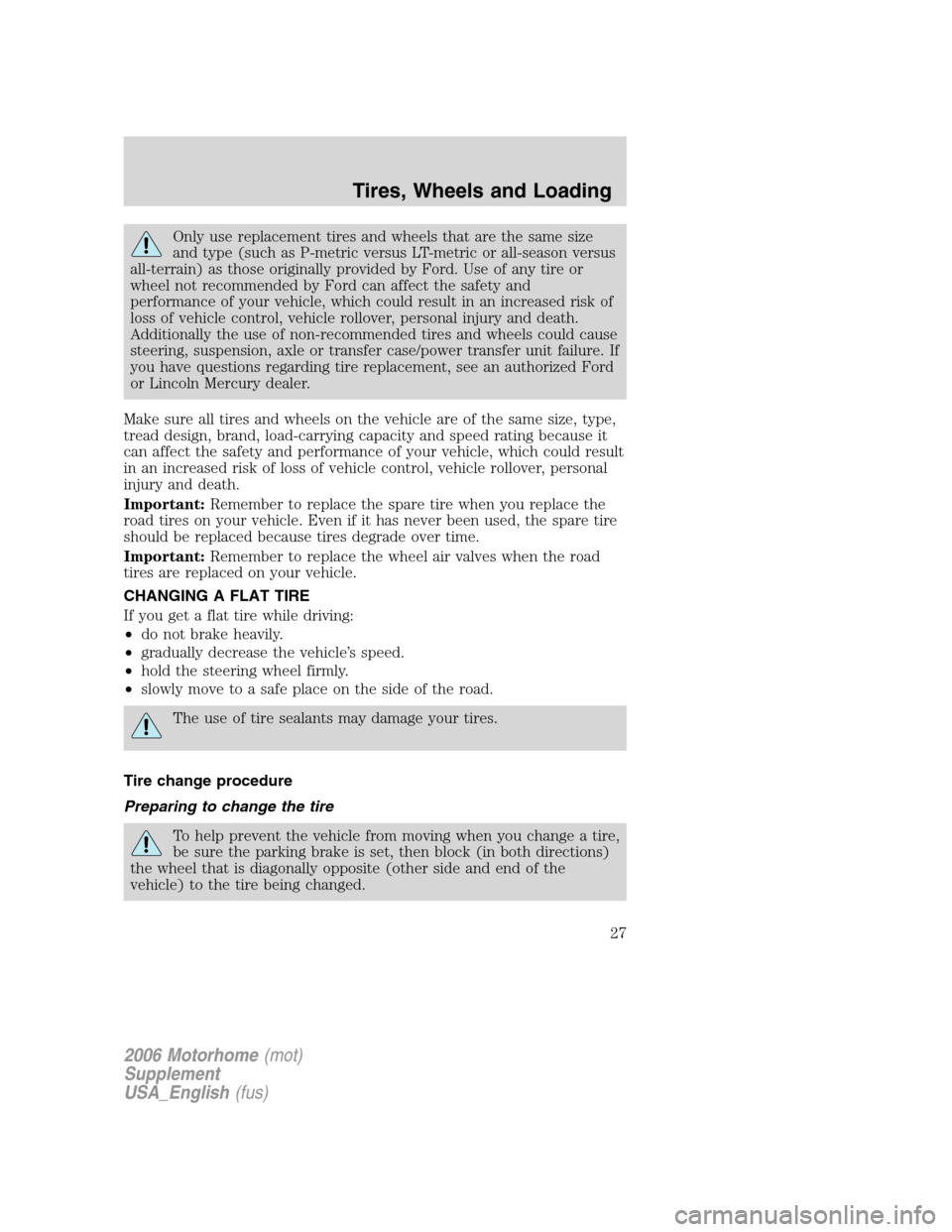
Only use replacement tires and wheels that are the same size
and type (such as P-metric versus LT-metric or all-season versus
all-terrain) as those originally provided by Ford. Use of any tire or
wheel not recommended by Ford can affect the safety and
performance of your vehicle, which could result in an increased risk of
loss of vehicle control, vehicle rollover, personal injury and death.
Additionally the use of non-recommended tires and wheels could cause
steering, suspension, axle or transfer case/power transfer unit failure. If
you have questions regarding tire replacement, see an authorized Ford
or Lincoln Mercury dealer.
Make sure all tires and wheels on the vehicle are of the same size, type,
tread design, brand, load-carrying capacity and speed rating because it
can affect the safety and performance of your vehicle, which could result
in an increased risk of loss of vehicle control, vehicle rollover, personal
injury and death.
Important:Remember to replace the spare tire when you replace the
road tires on your vehicle. Even if it has never been used, the spare tire
should be replaced because tires degrade over time.
Important:Remember to replace the wheel air valves when the road
tires are replaced on your vehicle.
CHANGING A FLAT TIRE
If you get a flat tire while driving:
•do not brake heavily.
•gradually decrease the vehicle’s speed.
•hold the steering wheel firmly.
•slowly move to a safe place on the side of the road.
The use of tire sealants may damage your tires.
Tire change procedure
Preparing to change the tire
To help prevent the vehicle from moving when you change a tire,
be sure the parking brake is set, then block (in both directions)
the wheel that is diagonally opposite (other side and end of the
vehicle) to the tire being changed.
2006 Motorhome(mot)
Supplement
USA_English(fus)
Tires, Wheels and Loading
27
Page 32 of 128
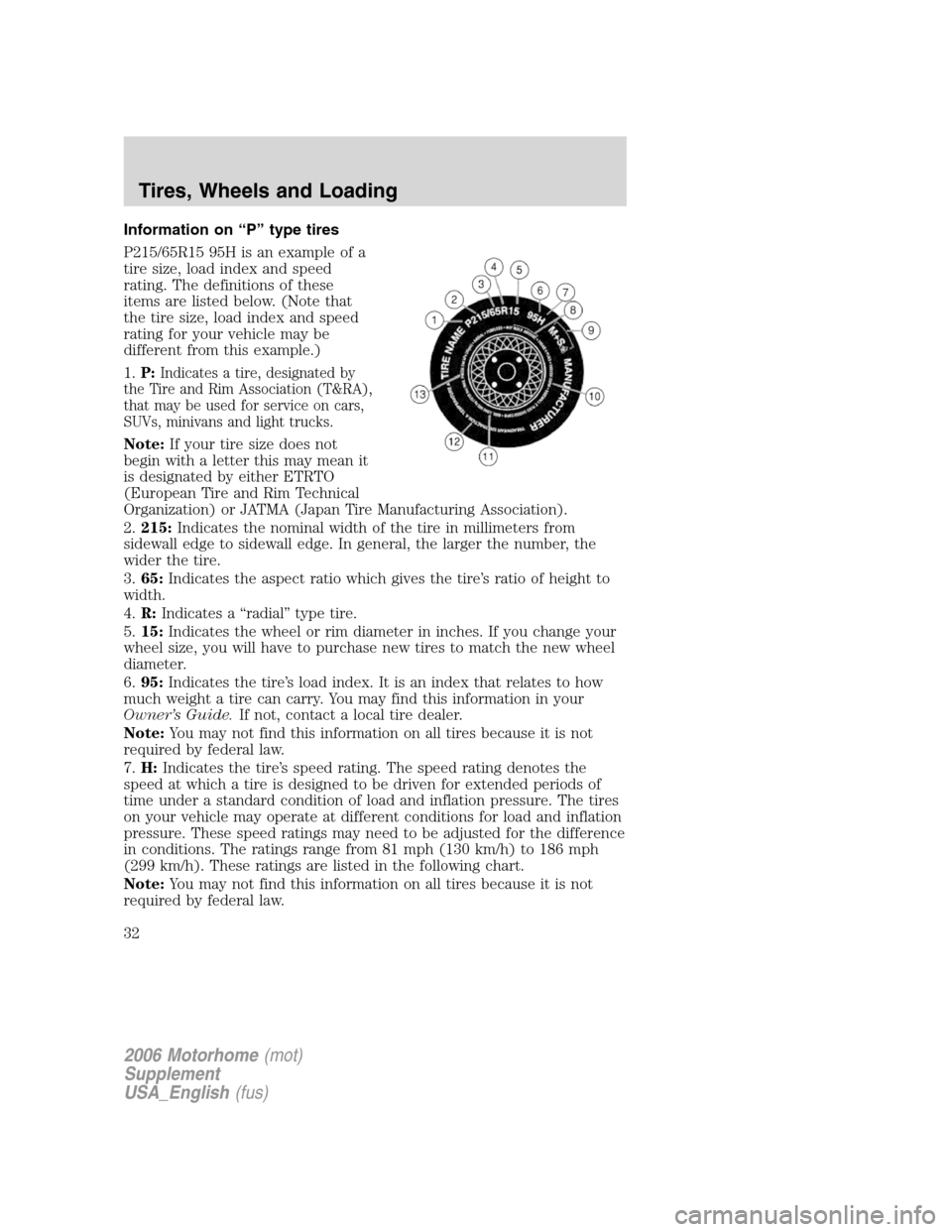
Information on “P” type tires
P215/65R15 95H is an example of a
tire size, load index and speed
rating. The definitions of these
items are listed below. (Note that
the tire size, load index and speed
rating for your vehicle may be
different from this example.)
1.P:
Indicates a tire, designated by
the Tire and Rim Association (T&RA),
that may be used for service on cars,
SUVs, minivans and light trucks.
Note:If your tire size does not
begin with a letter this may mean it
is designated by either ETRTO
(European Tire and Rim Technical
Organization) or JATMA (Japan Tire Manufacturing Association).
2.215:Indicates the nominal width of the tire in millimeters from
sidewall edge to sidewall edge. In general, the larger the number, the
wider the tire.
3.65:Indicates the aspect ratio which gives the tire’s ratio of height to
width.
4.R:Indicates a “radial” type tire.
5.15:Indicates the wheel or rim diameter in inches. If you change your
wheel size, you will have to purchase new tires to match the new wheel
diameter.
6.95:Indicates the tire’s load index. It is an index that relates to how
much weight a tire can carry. You may find this information in your
Owner’s Guide.If not, contact a local tire dealer.
Note:You may not find this information on all tires because it is not
required by federal law.
7.H:Indicates the tire’s speed rating. The speed rating denotes the
speed at which a tire is designed to be driven for extended periods of
time under a standard condition of load and inflation pressure. The tires
on your vehicle may operate at different conditions for load and inflation
pressure. These speed ratings may need to be adjusted for the difference
in conditions. The ratings range from 81 mph (130 km/h) to 186 mph
(299 km/h). These ratings are listed in the following chart.
Note:You may not find this information on all tires because it is not
required by federal law.
2006 Motorhome(mot)
Supplement
USA_English(fus)
Tires, Wheels and Loading
32
Page 36 of 128
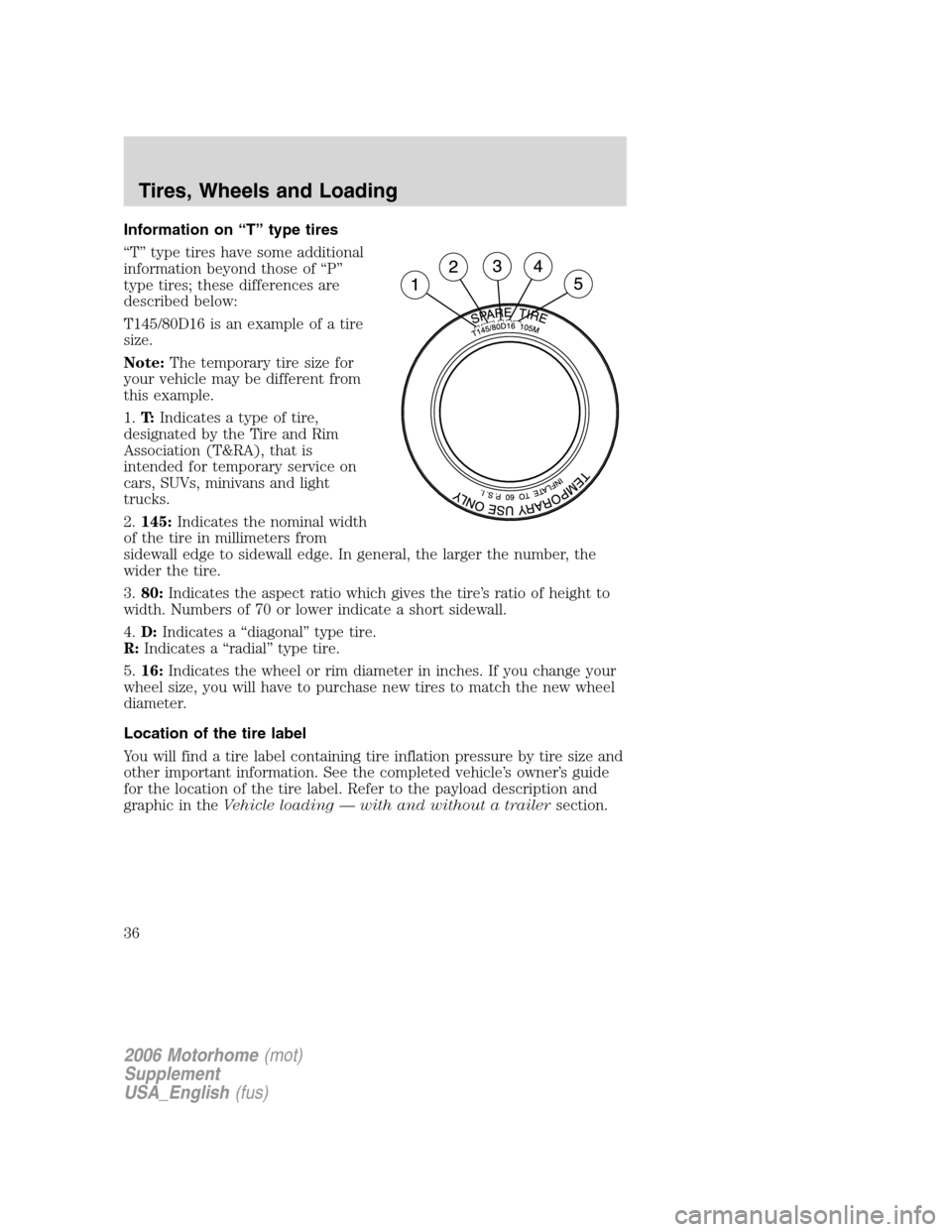
Information on “T” type tires
“T” type tires have some additional
information beyond those of “P”
type tires; these differences are
described below:
T145/80D16 is an example of a tire
size.
Note:The temporary tire size for
your vehicle may be different from
this example.
1.T:Indicates a type of tire,
designated by the Tire and Rim
Association (T&RA), that is
intended for temporary service on
cars, SUVs, minivans and light
trucks.
2.145:Indicates the nominal width
of the tire in millimeters from
sidewall edge to sidewall edge. In general, the larger the number, the
wider the tire.
3.80:Indicates the aspect ratio which gives the tire’s ratio of height to
width. Numbers of 70 or lower indicate a short sidewall.
4.D:Indicates a “diagonal” type tire.
R:Indicates a “radial” type tire.
5.16:Indicates the wheel or rim diameter in inches. If you change your
wheel size, you will have to purchase new tires to match the new wheel
diameter.
Location of the tire label
You will find a tire label containing tire inflation pressure by tire size and
other important information. See the completed vehicle’s owner’s guide
for the location of the tire label. Refer to the payload description and
graphic in theVehicle loading — with and without a trailersection.
2006 Motorhome(mot)
Supplement
USA_English(fus)
Tires, Wheels and Loading
36
Page 125 of 128
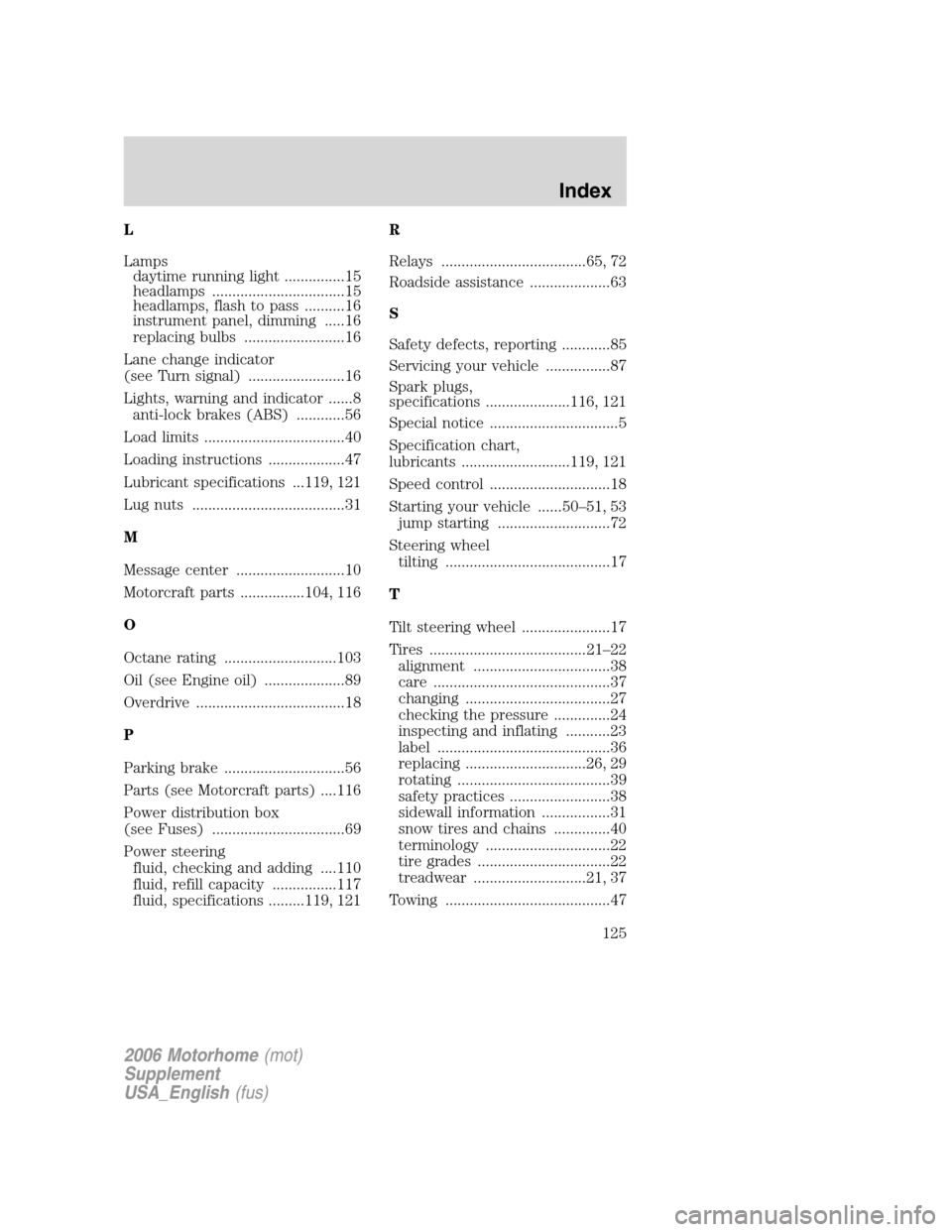
L
Lamps
daytime running light ...............15
headlamps .................................15
headlamps, flash to pass ..........16
instrument panel, dimming .....16
replacing bulbs .........................16
Lane change indicator
(see Turn signal) ........................16
Lights, warning and indicator ......8
anti-lock brakes (ABS) ............56
Load limits ...................................40
Loading instructions ...................47
Lubricant specifications ...119, 121
Lug nuts ......................................31
M
Message center ...........................10
Motorcraft parts ................104, 116
O
Octane rating ............................103
Oil (see Engine oil) ....................89
Overdrive .....................................18
P
Parking brake ..............................56
Parts (see Motorcraft parts) ....116
Power distribution box
(see Fuses) .................................69
Power steering
fluid, checking and adding ....110
fluid, refill capacity ................117
fluid, specifications .........119, 121R
Relays ....................................65, 72
Roadside assistance ....................63
S
Safety defects, reporting ............85
Servicing your vehicle ................87
Spark plugs,
specifications .....................116, 121
Special notice ................................5
Specification chart,
lubricants ...........................119, 121
Speed control ..............................18
Starting your vehicle ......50–51, 53
jump starting ............................72
Steering wheel
tilting .........................................17
T
Tilt steering wheel ......................17
Tires .......................................21–22
alignment ..................................38
care ............................................37
changing ....................................27
checking the pressure ..............24
inspecting and inflating ...........23
label ...........................................36
replacing ..............................26, 29
rotating ......................................39
safety practices .........................38
sidewall information .................31
snow tires and chains ..............40
terminology ...............................22
tire grades .................................22
treadwear ............................21, 37
Towing .........................................47
2006 Motorhome(mot)
Supplement
USA_English(fus)
Index
125